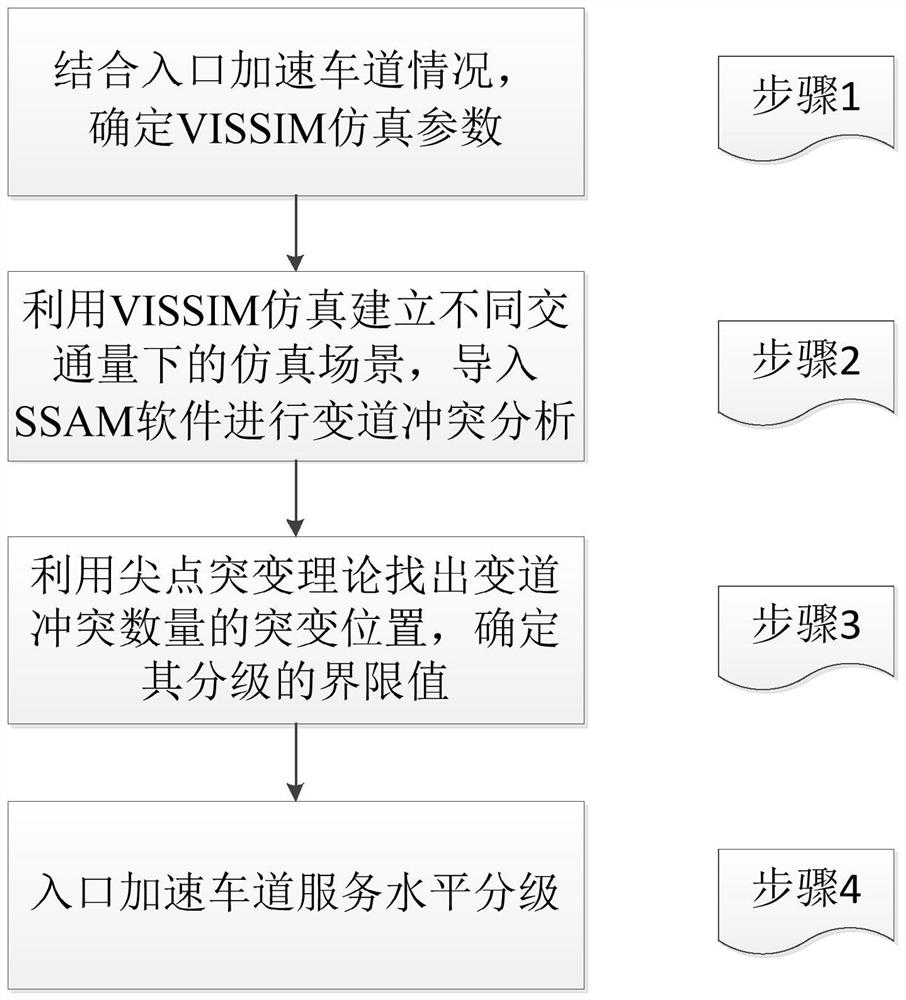Entrance acceleration lane service level grading method based on VISSIM simulation and lane change conflict
A technology of service level and grading method, applied in data processing applications, instruments, complex mathematical operations, etc., to achieve the effects of low cost of use, improved traffic efficiency, and real and reliable simulation results
- Summary
- Abstract
- Description
- Claims
- Application Information
AI Technical Summary
Problems solved by technology
Method used
Image
Examples
specific Embodiment approach 1
[0016] Specific implementation mode 1: In this implementation mode, a method for grading the service level of the entrance acceleration lane based on VISSIM simulation and lane change conflicts. The specific process is as follows:
[0017] Step 1: Combining the specific conditions of the entrance acceleration lane (lane length and width, type of acceleration lane, etc.), determine the simulation parameters;
[0018] Step 2: Use the simulation parameters in step 1 as VISSIM simulation modeling parameters, input the combination of different main line traffic volumes and ramp traffic volumes into the VISSIM simulation modeling software, and output the main line and ramp running trajectories (speed, acceleration, position, etc.);
[0019] Import the trajectory of the main line and the ramp into the traffic conflict analysis software SSAM to analyze the lane change conflict value, and form the correspondence table of the lane change conflict value under the different traffic volume ...
specific Embodiment approach 2
[0022] Specific embodiment two: the difference between this embodiment and specific embodiment one is that in the step 1, in conjunction with the specific conditions of the entrance acceleration lane (lane length and width, acceleration lane type, etc.), the simulation parameters are determined:
[0023] The simulation parameters include: main line speed limit value (for example, expressway operating speed limit 120), ramp speed limit value, ramp single-lane acceleration lane length (ramp is single lane), main line traffic volume, ramp traffic volume, traffic composition (passenger car , medium-sized cars, large-sized cars and the proportion of traffic composition of car trains), vehicle running speed, etc.
specific Embodiment approach 3
[0024] Specific implementation mode three: the difference between this implementation mode and specific implementation modes one or two is that in the step 3, the number of lane change conflicts is comprehensively analyzed, and the value of lane change conflicts is divided into intervals of equal steps and counted; the specific process is as follows :
[0025] Arrange and analyze the corresponding table of lane-changing conflict values obtained in step 2, and find the maximum and minimum conflict numbers in the corresponding table of lane-changing conflict values as max and min respectively;
[0026] Set the step size b (b≤3), and divide the conflicting values into [min,min+b], (min+b,min+2b]...(max-b,max]([min,min+b] ], (min+b, min+2b]...(max-b, max] total t groups) in the t group of intervals, and count the number of data y classified into each interval, and form the abscissa as the interval median The number x and the ordinate are the relationship table of the number...
PUM
 Login to View More
Login to View More Abstract
Description
Claims
Application Information
 Login to View More
Login to View More - R&D
- Intellectual Property
- Life Sciences
- Materials
- Tech Scout
- Unparalleled Data Quality
- Higher Quality Content
- 60% Fewer Hallucinations
Browse by: Latest US Patents, China's latest patents, Technical Efficacy Thesaurus, Application Domain, Technology Topic, Popular Technical Reports.
© 2025 PatSnap. All rights reserved.Legal|Privacy policy|Modern Slavery Act Transparency Statement|Sitemap|About US| Contact US: help@patsnap.com



